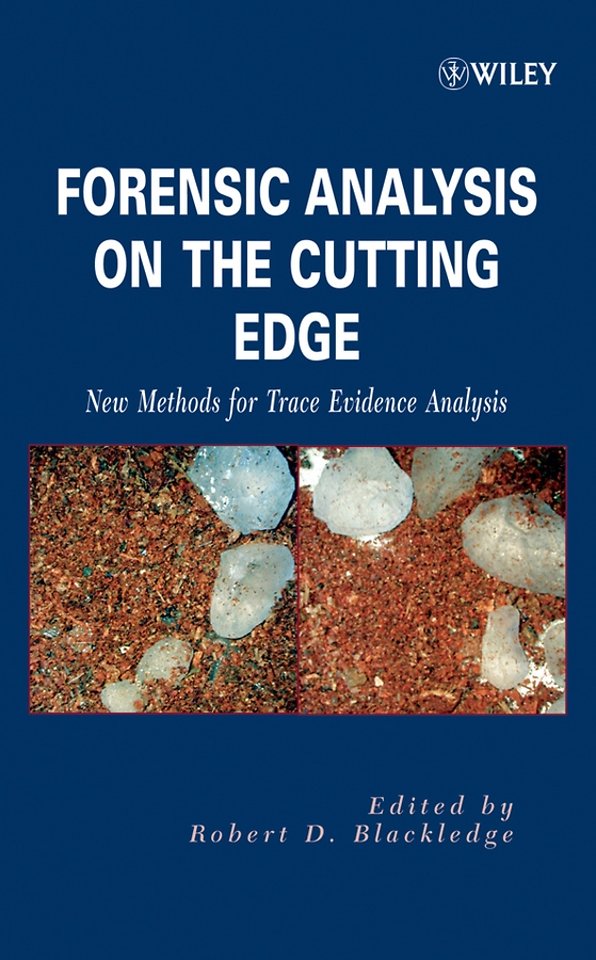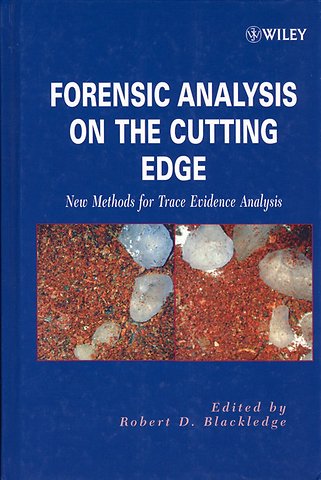Forensic Analysis on the Cutting Edge
New Methods for Trace Evidence Analysis
Samenvatting
Dit boek bevat bijdragen van wetenschappers uit het vakgebied van forensisch onderzoek. Zij geven u informatie over de huidige stand van de technologieën die gebruikt worden bij sporenonderzoek. Dit materiaal is vaak het bewijs dat de vermoedelijke dader op de plaats delict is geweest. Met veel cases uit de praktijk illustreert dit boek zowel de traditionele als nieuwe vormen van het onderzoek naar bewijsmateriaal.
Het boek behandelt:
- diverse methodieken, zoals massa spectrometrie, Raman microspectrometrie, statistische onderbouwing en nog veel meer;
- het analyseren van onder andere inkt, spermaresten, vezels, gebroken glas, contacten met airbags;
- Chemische opsporing van in eerste instantie onzichtbaar bewijsmateriaal, zoals bloedvlekken, vingerafdrukken en pepper spray.
Dit boek is vooral bedoeld voor wetenschappers werkzaam in forensische laboratoria over de hele wereld. Daarnaast is het fascinerende literatuur voor onder andere misdaadauteurs, advocaten, misdaadjournalisten.
Specificaties
Inhoudsopgave
Foreword
Contributors
1. All that Glitters Is Gold! (Robert D. Blackledge and Edwin L. Jones, Jr.).
1.1 What Is Glitter?
1.2 The Ideal Contact Trace
1.3 Characterization Methods
1.4 Glitter as Evidence in Criminal Cases
References
2. Forensic Analysis of Automotive Airbag Contact—Not Just a Bag of Hot Air (Glenn D. Schubert)
2.1 History of Airbags
2.2 How Do Airbags Work?
2.3 Types of Forensic Evidence to Look for
2.4 Airbag Case Reports and Examples
2.5 Changes that Are Occurring
2.6 Final Discussion
References
3. Ink Analysis Using UV Laser Desorption Mass Spectrometry (John Allison).
3.1 Introduction
3.2 The Instrumentation
3.3 The Analyte Target Molecules
3.4 LDMS for the Analysis of Dyes in Pen Inks
3.5 Related Applications
3.6 LDMS Analyses that 'Don't Work'
3.7 Conclusions
Acknowledgments
References
4. Condom Trace Evidence in Sexual Assaults: Recovery and Characterization (Wolfgang Keil)
4.1 Introduction
4.2 Examination for Condom Residue Traces
4.3 Forensic Evaluation of the Substances and Examinations
4.4 Case Studies
References
5. Latent Invisible Trace Evidence: Chemical Detection Strategies (Gabor Patonay, Brian Eckenrode, James John Krutak, Jozef Salon,and Lucjan Strekowski)
5.1 Introduction
5.2 Latent Bloodstain Detection
5.3 Fingerprint Detection with Near-Infrared Dyes
5.4 Pepper Spray Detection
References
6. Applications of Cathodoluminescence in Forensic Science (Christopher S. Palenik and JoAnn Buscaglia)
6.1 Introduction
6.2 Theory
6.3 Instrumentation
6.4 Techniques and Forensic Considerations
6.5 Luminescent Minerals
6.6 Forensic Applications
6.7 Geological Samples: Soil and Sand
6.8 Anthropogenic Materials
6.9 Conclusions and Outlook
Acknowledgments
References
7. Forensic Application of DARTTM (Direct Analysis in Real Time) Mass Spectrometry (James A. Laramée, Robert B. Cody, J. Michael Nilles, and H. Dupont Durst)
7.1 Introduction
7.2 Experimental
7.3 Drug and Pharmaceutical Analysis
7.4 Samples from the Human Body
7.5 Condom Lubricants
7.6 Dyes
7.7 Explosives
7.8 Arson Accelerants
7.9 Chemical Warfare Agents
7.10 Elevated-Temperature DART for Material Identification
7.11 Glues
7.12 Plastics
7.13 Fibers
7.14 Identification of Inks
7.15 Conclusion
Acknowledgments
References
8. Forensic Analysis of Dyes in Fibers Via Mass Spectrometry (Linda A. Lewis and Michael E. Sigman)
8.1 Introduction
8.2 Conventional Fiber Color Comparison Methods Employed in Forensic Laboratories
8.3 Shortcomings Associated with UV–Vis Based Comparative Analysis for Trace-Fiber Color Evaluations
8.4 General Overview of Modern Dye Ionization Techniques for Mass Analysis
8.5 Trace-Fiber Color Discrimination by Direct ESI-MS Analysis
8.6 Examples of Negative Ion ESI-MS Analysis of Colored Nylon Windings
8.7 Examples of Tandem Mass Spectrometry (MS/MS) Applications to Elucidate Structure
8.8 LC-MS Analysis of Dyes Extracted from Trace Fibers
8.9 Proposed Protocols to Compare Trace-Fiber Extracts
8.10 Conclusions
Acknowledgments
References
9. Characterization of Surface-Modified Fibers (Robert D. Blackledge and Kurt Gaenzle)
9.1 Fibers as Associative Evidence
9.2 Surface-Modified Fibers
9.3 Preliminary Examinations
9.4 Distinguishing Tests
Acknowledgments
References
10. Characterization of Smokeless Powders (Wayne Moorehead)
10.1 Introduction
10.2 Purpose of Analysis
10.3 Brief History of Smokeless Powder
10.4 Characterization Toward Smokeless Powder Identification
10.5 Characterization Toward Brand Identification
10.6 Micrometry
10.7 Mass
10.8 FTIR Spectroscopy
10.9 Chromatography with Mass Spectrometry
10.10 Conclusion
References
11. Glass Cuts (Helen R. Griffin)
11.1 A Homicide
11.2 A Robbery
11.3 A Hit and Run
11.4 Cutting Versus Tearing
11.5 Slash Cuts Made by Glass
11.6 Conclusion
Acknowledgments
References
Additional Sources
12. Forensic Examination of Pressure Sensitive Tape (Jenny M. Smith)
12.1 Introduction
12.2 Product Variability
12.3 Tape Construction
12.4 Duct Tape
12.5 Electrical Tape
12.6 Polypropylene Packaging Tape
12.7 Strapping/Filament Tapes
12.8 Masking Tape
12.9 Initial Handling
12.10 Methods
12.11 Case Example
Acknowledgments
References
Additional Sources
13. Discrimination of Forensic Analytical Chemical Data Using Multivariate Statistics (Stephen L. Morgan and Edward G. Bartick)
13.1 Patterns in Data
13.2 Experimental Design and Pre-processing
13.3 Dimensionality Reduction by Principal Component Analysis for Visualizing Multivariate Data
13.4 Visualizing Group Differences by Linear Discriminant Analysis
13.5 Group Separation, Classification Accuracy, and Outlier Detection
13.6 Selected Applications
13.7 Conclusion
Acknowledgments
References
14. The Color Determination of Optically Variable Flake Pigments (Michael R. Nofi)
14.1 Introduction
14.2 OVP: Form, Characteristics, and Function
14.3 Color Measurement
14.4 Color Blending
14.5 Additive Color Theory
14.6 Methods of Formulating OVP
14.7 Blending of Pigments
14.8 Microspectrophotometry
14.9 Measurement Geometry
14.10 Switching Objective Magnifications
14.11 Determining Sample Size
14.12 Measurement Uncertainty
14.13 Sample Preparation and Measurement
14.14 Spectral Profiling
14.15 Statistical Methods of Evaluation
14.16 Challenges for the Future
14.17 Other forensic Methods
Acknowledgments
References
Additional Sources
15. Forensic Science Applications of Stable Isotope Ratio Analysis (James R. Ehleringer, Thure E. Cerling, and Jason B. West)
15.1 What Are Stable Isotopes?
15.2 What Are the Units for Expressing the Abundance of Stable Isotopes?
15.3 What Is the Basis for Variations in Stable Isotope Abundances?
15.4 What Instrumentation Is Needed for High-Precision Stable Isotope Measurements?
15.5 How Can Stable Isotope Analyses Assist Forensics Cases?
15.6 Stable Isotope Abundances in Forensic Evidence
References
Index
Anderen die dit boek kochten, kochten ook
Net verschenen
Rubrieken
- aanbestedingsrecht
- aansprakelijkheids- en verzekeringsrecht
- accountancy
- algemeen juridisch
- arbeidsrecht
- bank- en effectenrecht
- bestuursrecht
- bouwrecht
- burgerlijk recht en procesrecht
- europees-internationaal recht
- fiscaal recht
- gezondheidsrecht
- insolventierecht
- intellectuele eigendom en ict-recht
- management
- mens en maatschappij
- milieu- en omgevingsrecht
- notarieel recht
- ondernemingsrecht
- pensioenrecht
- personen- en familierecht
- sociale zekerheidsrecht
- staatsrecht
- strafrecht en criminologie
- vastgoed- en huurrecht
- vreemdelingenrecht







